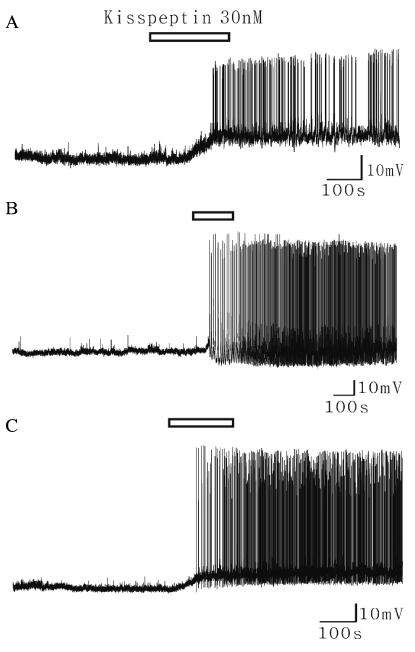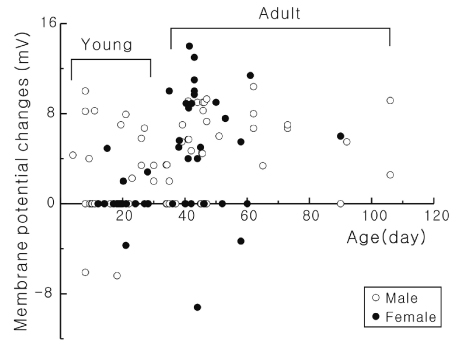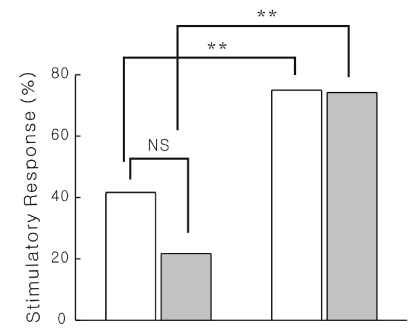J Korean Endocr Soc.
2008 Oct;23(5):302-309. 10.3803/jkes.2008.23.5.302.
Age-dependent Kisspeptin Effects on the GnRH Neurons in Male and Female Mice
- Affiliations
-
- 1Department of Oral Physiology, School of Dentistry, Chonbuk National University, Korea.
- 2Department of Preventive Dentistry & Institute of Oral Bioscience, School of Dentistry, Chonbuk National University, Korea.
- 3Laboratory of Veterinary Pharmacology, College of Veterinary Medicine, Seoul National University, Korea.
- KMID: 1479222
- DOI: http://doi.org/10.3803/jkes.2008.23.5.302
Abstract
-
BACKGROUND: The gonadotropin releasing hormone (GnRH) neurons play a pivotal role in the central regulation of fertility. Kisspeptin binds to the G-protein coupled receptor 54 (GPR54) and GPR54 has been shown to be essential for puberty and subsequent fertility in humans. The recent in vivo studies have proved that kisspeptin is an extremely potent activator of GnRH neurons. However, the precise mechanism of action of kisspeptin on the GnRH neurons and the age-dependent kisspeptin effects are not yet fully understood. In this study, we investigated the effects of kisspeptin on the GnRH neurons over the developmental stages in male and female mice.
METHODS
Young (< P30) and adult (> P35) GnRH-GFP transgenic mice expressing green fluorescent protein were used in this study. Acute coronal brain slices containing the preoptic area were prepared, and the identified GnRH neurons were recorded using the gramicidin perforated-patch clamp technique.
RESULTS
In young mice, GnRH neurons were excited by bath application of kisspeptin in 36% (13/36) in male, 17% (4/23) in female tested neurons. In adult mice, GnRH neurons were excited in the majority (30/40, 75%) in male, (21/31, 68%) in female neurons tested. However, there was no significant difference between the effects of kisspeptin in male and female mice. In addition, we tested kisspeptin effects in diestrus, proestrus and estrus animals. There were no significant differences of kisspeptin effects over the estrous cycle. Kisspeptin failed to induce excitatory effects on GnRH neurons (6/7, 86%) neurons) by pretreatment of U73122, a protein lipase C (PLC) inhibitor and kisspeptin-induced excitatory effects were decreased by U73122 application (n = 2).
CONCLUSION
These results demonstrated that kisspeptin-induced membrane excitability was increased after puberty and this supports a previous suggestion that GPR54 is essential for puberty and subsequent fertility.
Keyword
MeSH Terms
-
Adult
Animals
Baths
Brain
Diestrus
Estrenes
Estrous Cycle
Estrus
Female
Fertility
Gonadotropin-Releasing Hormone
Gramicidin
GTP-Binding Proteins
Humans
Lipase
Male
Membranes
Mice
Mice, Transgenic
Neurons
Preoptic Area
Proestrus
Puberty
Pyrrolidinones
Estrenes
GTP-Binding Proteins
Gonadotropin-Releasing Hormone
Gramicidin
Lipase
Pyrrolidinones
Figure
Reference
-
1. Herbison AE. Henry H, Norman A, editors. GnRH neuron. Encyclopedia of hormones. 2003. Vol 2. San Diego: Academic Press;171–177.2. Clarkson J, Herbison AE. Postnatal development of kisspeptin neurons in mouse hypothalamus; sexual dimorphism and projections to gonadotropin releasing hormone neurons. Endocrinology. 2006. 147:5817–5825.3. Parhar IS, Ogawa S, Sakuma Y. Laser-captured single digoxigenin-labeled neurons of gonadotropin-releasing hormone types reveal a novel G protein coupled receptor (GPR54) during maturation in cichlid fish. Endocrinology. 2004. 145:3613–3618.4. Irwig MS, Fraley GS, Smith JT, Acohido BV, Popa SM, Cunningham MJ, Gottsch ML, Clifton DK, Steiner RA. Kisspeptin activation of gonadotropin releasing hormone neurons and regulation of KiSS-1 mRNA in the male rat. Neuroendocrinology. 2004. 80:264–272.5. Messager S, Chatzidaki EE, Ma D, Hendrick AG, Zahn D, Dixon J, Thresher RR, Malinge I, Lomet D, Carlton MB, Colledge WH, Caraty A, Aparicio SA. Kisspeptin directly stimulates gonadotropin-releasing hormone release via G protein-coupled receptor 54. Proc Natl Acad Sci USA. 2005. 102:1761–1766.6. Navarro VM, Castellano JM, Fernandez-Fernandez R, Barreiro ML, Roa J, Sanchez-Criado JE, Aguilar E, Dieguez C, Pinilla L, Tena-Sempere M. Developmental and hormonally regulated messenger ribonucleic acid expression of KiSS-1 and its putative receptor, GPR54, in rat hypothalamus and potent luteinizing hormone-releasing activity of KiSS-1 peptide. Endocrinology. 2004. 145:4565–4674.7. Gottsch ML, Cunningham MJ, Smith JT, Popa SM, Acohido BV, Crowley WF, Seminara S, Clifton DK, Steiner RA. A role for kisspeptins in the regulation of gonadotropin secretion in the mouse. Endocrinology. 2004. 145:4073–4077.8. Shahab M, Mastronardi C, Seminara SB, Crowley WF, Ojeda SR, Plant TM. Increased hypothalamic GPR54 signaling: A potential mechanism for initiation of puberty in primates. Proc Natl Acad Sci USA. 2005. 102:2129–2134.9. Han SK, Gottsch ML, Lee KJ, Popa SM, Smith JT, Jakawich SK, Clifton DK, Steiner RA, Herbison AE. Activation of gonadotropin-releasing hormone (GnRH) neurons by kisspeptin as a neuroendocrine switch for the onset of puberty. J Neurosci. 2005. 25:11349–11356.10. Liu X, Lee KH, Herbison AE. Kisspeptin excites gonadotropin-releasing hormone (GnRH) neurons through a phospholipase C/calcium-dependent pathway regulating multiple ion channels. Endocrinology. May 15, 2008 [Epub ahead of print].11. Zhang C, Roepke TA, Kelly MJ, Rønnekleiv OK. Kisspeptin depolarizes gonadotropin-releasing hormone neurons through activation of TRPC-like cationic channels. J Neurosci. 23. 28:4423–4434.12. Suter KJ, Song WJ, Sampson TL, Wuarin JP, Saunders JT, Dudek FE, Moenter SM. Genetic targeting of green fluorescent protein to gonadotropin-releasing hormone neurons: characterization of whole-cell electrophysiological properties and morphology. Endocrinology. 2000. 141:412–419.13. Spergel DJ. Calcium and small-conductance calciumactivated potassium channels in gonadotropin-releasing hormone neurons before, during, and after puberty. Endocrinology. 2007. 148:2383–2390.14. Han SK, Todman MG, Herbison AE. Endogenous GABA release inhibits the firing of adult gonadotropin releasing hormone neurons. Endocrinology. 2004. 145:495–499.15. Rhee JS, Ebihara S, Akaike N. Gramicidin perforated patch-clamp technique reveals glycine-gated outward chloride current in dissociated nucleus solitari neurons of the rat. J Neurophysiol. 1994. 72:1103–1108.16. Urbanski HF, Fahy MM, Daschel M, Meshul C. N-methyl-D-aspartate receptor gene expression in the hamster hypothalamus and in immortalized luteinizing hormone-releasing hormone neurones. J Reprod Fertil. 1994. 100:5–9.17. Plant TM, Barker-Gibb ML. Neurobiological mechanisms of puberty in higher primates. Hum Reprod Update. 2004. 10:67–67.18. Terasawa E, Fernandez DL. Neurobiological mechanisms of the onset of puberty in primates. Endocr Rev. 2001. 22:111–115.19. Grumbach MM. The neuroendocrinology of human puberty revisited. Horm Res. 2002. 57:Suppl 2. 2–14.20. Matsui H, Takatsu Y, Kumano S, Matsumoto H, Ohtaki T. Peripheral administration of metastin induces marked gonadotropin release and ovulation in the rat. Biochem Biophys Res Commun. 2004. 320:383–388.21. Seminara SB, Messager S, Chatzidaki EE, Thresher RR, Acierno JS Jr, Shagoury JK, Bo-Abbas Y, Kuohung W, Schwinof KM, Hendrick AG, Zahn D, Dixon J, Kaiser UB, Slaugenhaupt SA, Gusella JF, O'Rahilly S, Carlton MB, Crowley WF Jr, Aparicio SA, Colledge WH. The GPR54 gene as a regulator of puberty. N Engl J Med. 2003. 349:1614–1627.22. Kauffman AS, Gottsch ML, Roa J, Byquist AC, Crown A, Clifton DK, Hoffman GE, Steiner RA, Tena-Sempere M. Sexual differentiation of Kiss1 gene expression in the brain of the rat. Endocrinology. 2007. 148:1774–1783.23. Smith JT, Dungan HM, Stoll EA, Gottsch ML, Braun RE, Eacker SM, Clifton DK, Steiner RA. Differential regulation of KiSS-1 mRNA expression by sex steroids in the brain of the male mouse. Endocrinology. 2005. 146:2976–2984.24. Pielecka-Fortuna J, Chu Z, Moenter SM. Kisspeptin acts directly and indirectly to increase GnRH neuron activity and its effects are modulated by estradiol. Endocrinology. 2008. 149:1979–1986.25. Castellano JM, Navarro VM, Fernandez-Fernandez R, Castano JP, Malagon MM, Aguilar E, Dieguez C, Magni P, Pinilla L, Tena-Sempere M. Ontogeny and mechanisms of action for the stimulatory effect of kisspeptin on gonadotropin- releasing hormone system of the rat. Mol Cell Endocrinol. 2006. 257-258:75–83.
- Full Text Links
- Actions
-
Cited
- CITED
-
- Close
- Share
- Similar articles
-
- Kisspeptin Regulation of Neuronal Activity throughout the Central Nervous System
- Effects of Dopamine on the Gonadotropin Releasing Hormone(GnRH) Neurons
- Comprehensive Review on Kisspeptin and Its Role in Reproductive Disorders
- Kisspeptin and DLK1 levels for monitoring treatment of girls with central precocious puberty
- Serum Kisspeptin Levels in Korean Girls with Central Precocious Puberty







